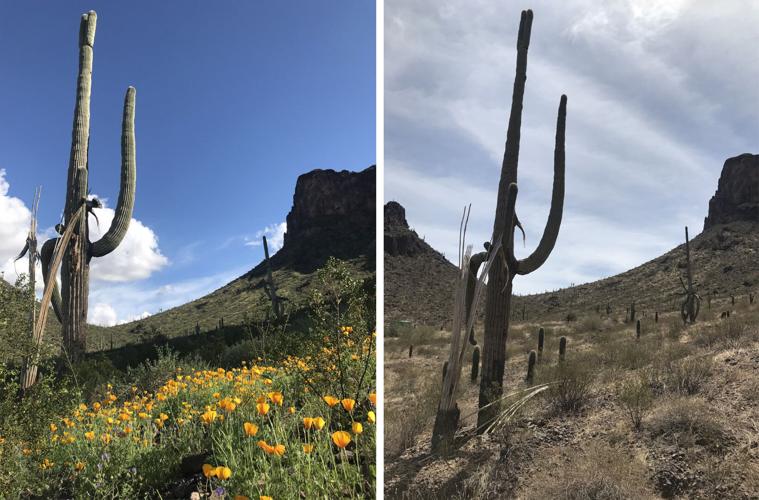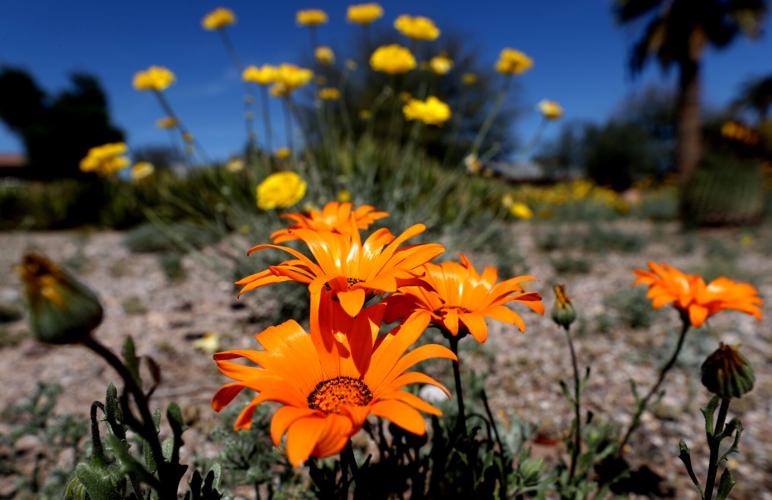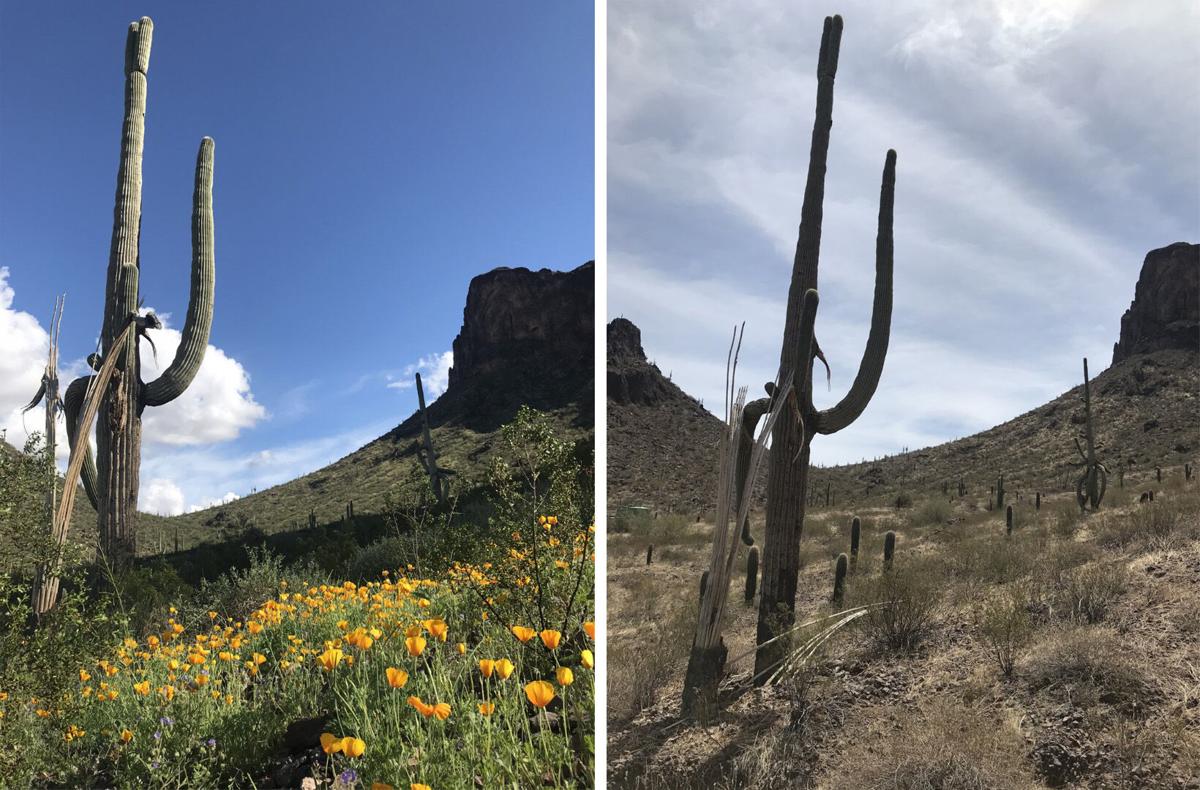Winter has only just begun, but wildflower forecasters are already looking forward to spring.
So what might the recent rains in the desert mean for next year’s bloom?
“Every botanist out there is pondering the same question,” said Jim Malusa, research scientist with the University of Arizona School of Natural Resources and the Environment. “Nothing motivates the seeds of spring annuals better than an early winter rain, but how much rain is enough rain?”
So far this month, the National Weather Service has recorded 1.19 inches at its official gauge at Tucson International Airport. That’s a little over twice the normal amount for this time in December, thanks to a pair of weather systems about nine days apart.
Malusa said both storms were pretty widespread from Nogales to Casa Grande and delivered enough moisture to spur growth in at least some of the seeds still hiding in the ground from previous blooms.
Desert ecologist Ben Wilder said the rain so far has been a nice surprise considering we’re supposed to be headed into our second straight La Niña winter, which typically means dry conditions in the Sonoran Desert.
“The timing has been pretty ideal to really bump up the soil moisture and have that sustained for about a month,” Wilder said.
He thinks more rain needs to fall to spark a widespread bloom, but areas such as Picacho Peak did well enough during the first two storms to trigger germination.
“Now the concern is freezes,” Wilder said.
The first cold snap shortly after the recent storms probably didn’t pose much of a threat to the newly sprouting seeds, he said, but subsequent ones will.
“I would say chances are good for some decent flowers around the Picacho Peak area if additional freezes hold off,” Wilder said. “And they could be good or really good in that area — and more regionally — with additional rains in the coming weeks.”
Mark Dimmitt is the retired director of natural history at the Arizona-Sonora Desert Museum. Now he maintains a sprawling collection of unusual plants in his garden and greenhouses on Tucson’s west side.

A few varieties of wildflowers popped up at Wilson Avenue and Juanita Street in the Catalina Vista neighborhood in 2020.
He said the ground in his neighborhood is already “greening up” from the rain so far this month on the eastern slope of the Tucson Mountains, hinting at a “mass germination of annual seeds.”
Unfortunately, the desert may have already missed its chance for anything better than a decent show of color.
“The ideal formula for a massive wildflower bloom is a soaking rain in October or November, followed by at least an inch of rain per month through February,” Dimmitt said. “This December start is a little late, but the bloom could still be good if the winter is on the warm side so the seedlings can make good growth before warmer spring weather stimulates flowering.”
An “anomalously wet winter rainy season” would also help, he said, though La Niña may have other plans.
If you can’t wait until spring to see some flowers, Dimmitt said he’s getting early reports — and a few photos — of “sand verbena, desert sunflower and a few desert lilies” that are already in bloom at Anza-Borrego State Park in California‘s Mojave Desert.
Closer to home, though, Malusa said it is still too soon to know anything with certainty — even with the promising storms earlier this month.
“Last year we also had 1 to 2 inches around Tucson in December, and then less than an inch until the summer monsoons arrived. The spring annual bloom was a dud,” he said.
But Malusa is more of a field-is-half-full kind of guy when it comes to wildflowers. Even during a down year, the desert can still surprise you, he said.
“If the rains fail in January and February, there are always brittlebush and baby bonnets and palo verde — perennial shrubs and trees that, with meager spring rainfall, still most always provide a spring show,” Malusa said. “The palo verdes were fabulous last year.”
Cactus blooms are more reliable than wildflowers because they require less rain. With enough water, they can have multiple bloom cycles. Photos by Doug Kreutz, Arizona Daily Star
Photos: Wildflowers in bloom around Tucson, 2020
Wildflowers around Tucson, 2020
Updated
A Blue Lupines stands out from the Gold Poppies and purple Owl's Clover on the Sutherland Trail in Catalina State Park.
Wildflowers around Tucson, 2020
Updated
Diane Stowell, front, hikes past a group of Mexican and California Gold Poppies and Blue Lupines with her husband Curt Stowell on the Sutherland Trail in Catalina State Park.
Wildflowers around Tucson, 2020
Updated
Light shines on a group of Desert Chicory on the Sutherland Trail in Catalina State Park.
Wildflowers around Tucson, 2020
Updated
A Penstemon stands next to a trail on the Sutherland Trail in Catalina State Park.
Wildflowers around Tucson, 2020
Updated
A hiker walks past a trail lined with Mexican and California Gold Poppies as he heads back to the main trail on the Sutherland Trail in Catalina State Park.
Wildflowers around Tucson, 2020
Updated
A group of Purple Owl's Clover stand out in front of a bed Gold Poppies on the Sutherland Trail in Catalina State Park.
Wildflowers around Tucson, 2020
Updated
Edita Navratilova, right, takes pictures of a group of Mexican and California Gold Poppies on the Sutherland Trail in Catalina State Park.
Wildflowers around Tucson, 2020
Updated
From left to right, Gabriella Porreca, Edita Navratilova and Frank Porreca hike past a bed of Mexican and California Gold Poppies on the Sutherland Trail in Catalina State Park.
Wildflowers around Tucson, 2020
Updated
Desert Blue Bells bloom in front of a home in River View Estates, in Tucson, Ariz., on March 29, 2020.
Wildflowers around Tucson, 2020
Updated
A group of Penstemon bloom in front of a home in River View Estates, in Tucson, Ariz., on March 29, 2020.
Wildflowers around Tucson, 2020
Updated
Matthew Halteman, left, and Stephanie Halteman walk with their daughter Brady Halteman, 2, along a line of wildflowers in bloom on E. Old Spanish Trail in Tucson, Ariz., on March 29, 2020. The Halteman family decided to go for a walk to get out of the house. East Old Spanish Trail is a popular street lined with wildflowers.
Wildflowers around Tucson, 2020
Updated
An Aloe Vera plant's flower stalks bloom along a wall on E. Wrightstown Rd., in Tucson, Ariz., on March 29, 2020.
Wildflowers around Tucson, 2020
Updated
A group of Lupines and Desert Globemallow begin to bloom along N. Kolb Rd., in Tucson, Ariz., on March 29, 2020. Along N. Kolb Rd., between N. Sabino Canyon Rd. and E. Sunrise Dr., the street is lined will Brittlebush and other wildflowers.
Wildflowers around Tucson, 2020
Updated
A Penstemon in bloom along Tangerine near Sage Brook and the Verde Ranch neighborhood, Saturday, March 28, 2020, Tucson, Ariz. Wildflowers are blooming long both sides of Tangerine in the area.
Wildflowers around Tucson, 2020
Updated
A few varieties of wildflowers are popping up in an island at Wilson Avenue and Juanita Street in Catalina Vista, Saturday, March 28, 2020, Tucson, Ariz.
Wildflowers around Tucson, 2020
Updated
Flowers sprouting up from the curb in Poets Square, on March 28, 2020.
Wildflowers around Tucson, 2020
Updated
Flowers outside the neighborhood garden in Dunbar Spring, on March 28, 2020.
Wildflowers around Tucson, 2020
Updated
A bee lands on a flower in the community garden in Dunbar Spring, on March 28, 2020.
Wildflowers around Tucson, 2020
Updated
Flowers bloom in the Dunbar Spring community garden, on March 28, 2020.
Wildflowers around Tucson, 2020
Updated
Flowers bloom in the Dunbar Spring community garden, on March 28, 2020.
Wildflowers around Tucson, 2020
Updated
Flowers against a wall of a home in Dunbar Spring, on March 28, 2020.
Wildflowers around Tucson, 2020
Updated
A group of Brittlebush bloom in front of a house along N. Kolb Rd., in Tucson, Ariz., on March 29, 2020. Along N. Kolb Rd., between N. Sabino Canyon Rd. and E. Sunrise Dr., the street is lined will Brittlebush and other wildflowers.






